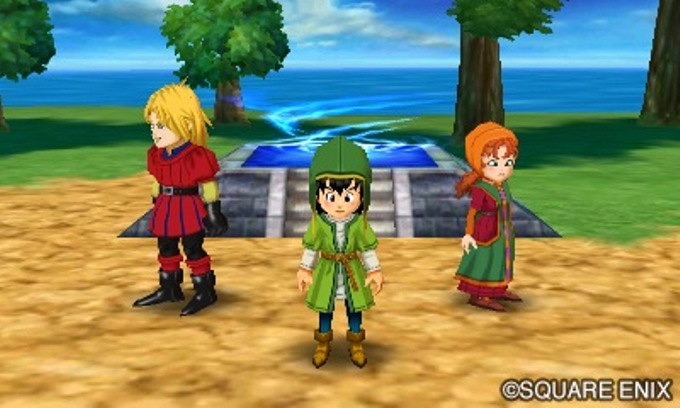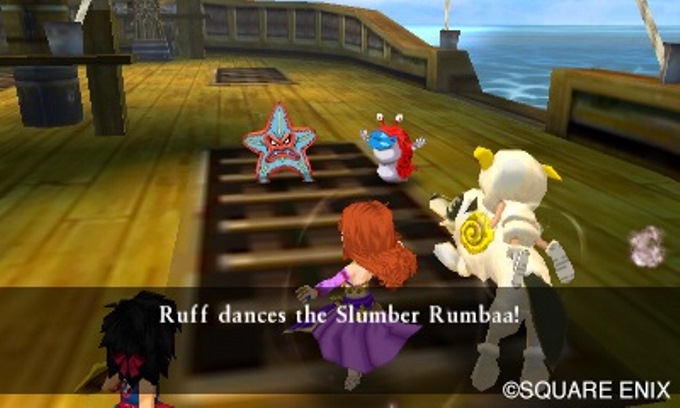[Review] Dragon Quest VII: Fragments of the Forgotten Past
Posted on September 13, 2016 by Philip(@P_Trah) in 3DS, Reviews
System: 3DS
Release date: September 16, 2016
Developer: ArtePiazza / Square Enix
Publisher Nintendo
Dragon Quest has had a very interesting history outside of Japan. Known earlier as Dragon Warrior in North America due to trademark issues, the series wasn’t nearly as popular over here as it was in Japan, being somewhat of a cultural phenomenon overseas. Despite its very low sales in the states, the various games have been relatively well received by those who’ve given the franchise a shot, and over the years have garnered a fairly large fan base in the west. Square Enix, in partnership with Nintendo, has now fully remade one of the most beloved entries in the series for the 3DS: Dragon Warrior VII. So, how does Dragon Quest VII: Fragments of the Forgotten Past hold up not only as a remake, but also as a brand new title on Nintendo’s handheld?
Your adventure begins in your hometown Pilchard, which is located on the small island of Estard. Estard’s inhabitants believe that it is the only island in the world and is solely surrounded by ocean for as far as the eye can see. However, you and your childhood friend Prince Keifer believe otherwise, and have recently been planning a way to uncover the truth. Keifer believes that the answer is somewhere within some sealed ruins, and the two friends begin searching for a way inside. Eventually, the two friends, joined by the daughter of the mayor of Pilchard, meet the guardian of the ruins who shows the trio a room filled with empty stone pedestals engraved with what looks like a large number of different islands. Noticing some of these pedestals have different colored fragments already placed inside, the guardian tasks the heroes with finding the missing tablet fragments which, upon completion, reveal brand new locations to explore.
It’s important to note that even though Fragments of the Forgotten Past is a remake of Dragon Warrior VII for the PlayStation, it is still very much an old-school JRPG. The early game is very plot heavy and involves a lot of world building, exploration, and puzzle-solving. In fact, you don’t actually experience any combat until around three hours in. Despite that, I was never bored during those early hours. This was because the character dialogue and story buildup were so incredibly engrossing. I was always stopping to talk to every NPC I came across as they usually had something charming or funny to say. The pacing gradually speeds up as you continue and unlock various means of traversing the world, but it stays relatively slow throughout its entire first quarter. It’s clear that the game really wants you to take your time and explore the world that is being, quite literally, created around you and I found that very refreshing. I enjoyed exploring islands thoroughly and soaking in the story as opposed to just going straight from dungeon to dungeon with no breaks in between. Even though I liked the overall pacing, I know it’s going to be a very divisive aspect for people. Being on the 3DS helps immensely as you’re not constrained in any way and can take the game wherever you want; however, this definitely isn’t something for those who want a 30 to 40 hour RPG, as it will easily take you more than 80 hours to experience everything it has to offer.
Even though Dragon Quest VII is pretty slow-paced, the localization is so great that it makes time spent exploring feel worth every minute. I was thoroughly impressed at just how much attention to detail went into almost every aspect of the writing. Whether it’s through talking with a slime and hearing them slip words like “gooreat” into their dialogue or seeing town names that are clever puns having to do with the islands theme, the writing always feels like it was created with extreme care and thought. The same goes for the different islands and its inhabitants. Each island you uncover has its own unique and often interesting story to tell, with an interesting cast of characters that feel realized and fleshed-out.
Another thing that makes the world of Fragments of the Forgotten Past feel alive and believable is the varied dialects the localization team gave different islands. Ranging from Spanish to Germanic and everything in between, these dialects make the islands feel more like continents and add to the overall world. They aren’t flawless though, as some are sometimes hard to understand and feel almost exhausting to read through, especially when they are important to the story. Whenever I came across these types of dialects, I would sometimes find myself unconsciously advancing NPC dialogue without reading it solely because it felt too cumbersome to try and decipher what they were getting at. Thankfully, they are few and far-between and are only a minor annoyance the handful of times they appear.
The story in Fragments of the Forgotten Past is another one of its stronger elements, and is structured pretty differently from other JRPGs. The main plot revolves around reviving different islands around the world. Each one tells its own story that pieces together the overall sequence of events. As you uncover new areas and solve their problems, you get closer and closer to uncovering the truth of why the islands disappeared and who the culprit behind it all is. I found that this structure kept the experience fresh, as it gave me a desire to continually uncover islands because I never knew what strange curse or threat was troubling the inhabitants of the next new island I discovered; and by resolving that island’s story, I was getting one step closer to uncovering the overall mystery of the game’s world. There are a select few islands here and there that feel very slow and dull, though they don’t detract from some of the more interesting and story driven ones.
Throughout my time playing, there were only a handful of times I felt lost and unsure of how to move the story along. Progression is structured in a way where by exploring new islands in the past and present, you will guarantee yourself a way uncover the next island, and this process is shown to you many times in the beginning of the game. However, when I did feel lost, there were a handful of very helpful menu options that either vaguely described where my next objective was or detailed the most recent development in the story to give me just enough info to remind me what I had just done and where I should think about going next. I greatly appreciated that it was never really spelled out where my next objective was, but also never left me completely in the dark.
When it comes to the combat system, enemies can be seen roaming around the world map and in dungeons, and battles begin when you run into them. As mentioned before, the pacing of the game is relatively slow and the combat progression is no exception. For the majority of the early sections, you’ll find that most fights feel relatively simplistic. However, as you level up, you gain abilities and spells that accomplish a variety of things, like inflicting status effects, hitting all enemies, buffing party members, or debuffing enemies. This helps add strategy to the early combat encounters, but the only time it felt overly necessary or worthwhile in the early parts was during boss fights. This all changes after the introduction of Dragon Quest’s traditional class system.


